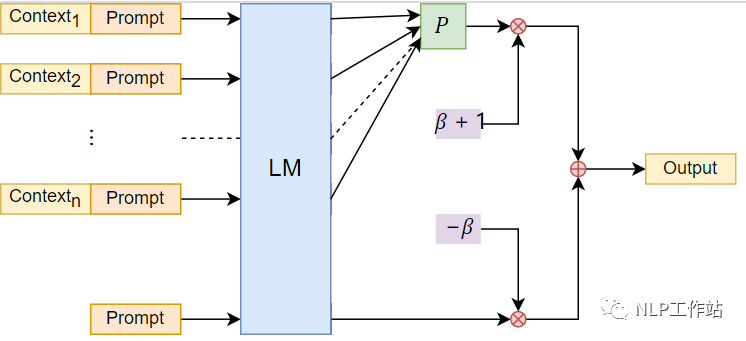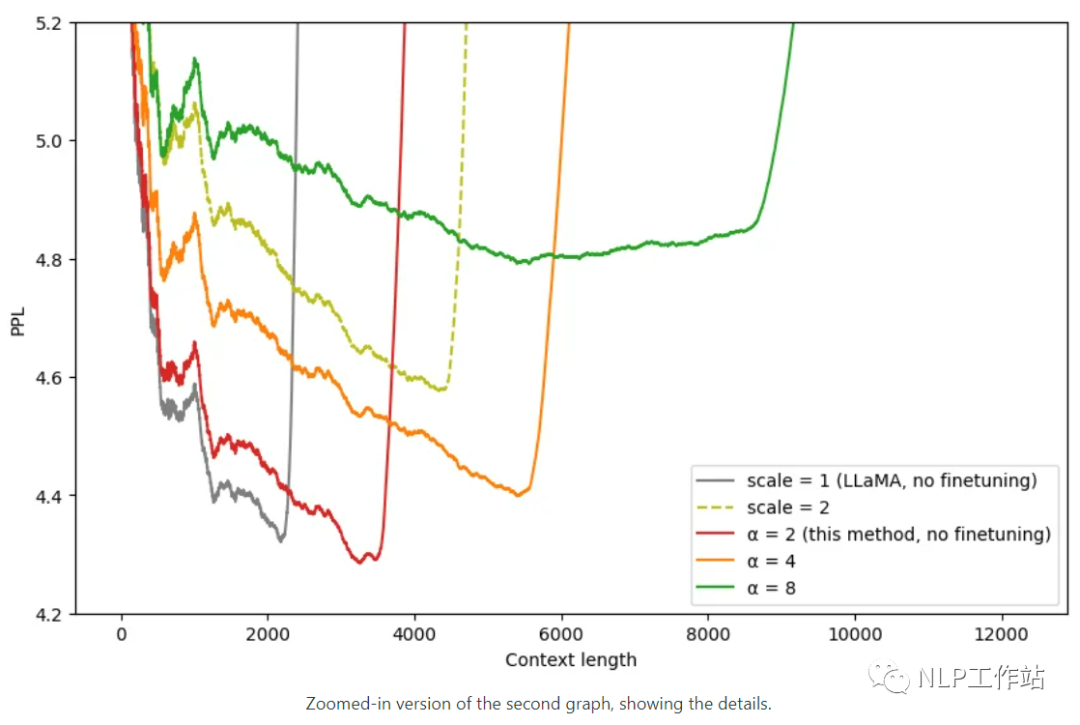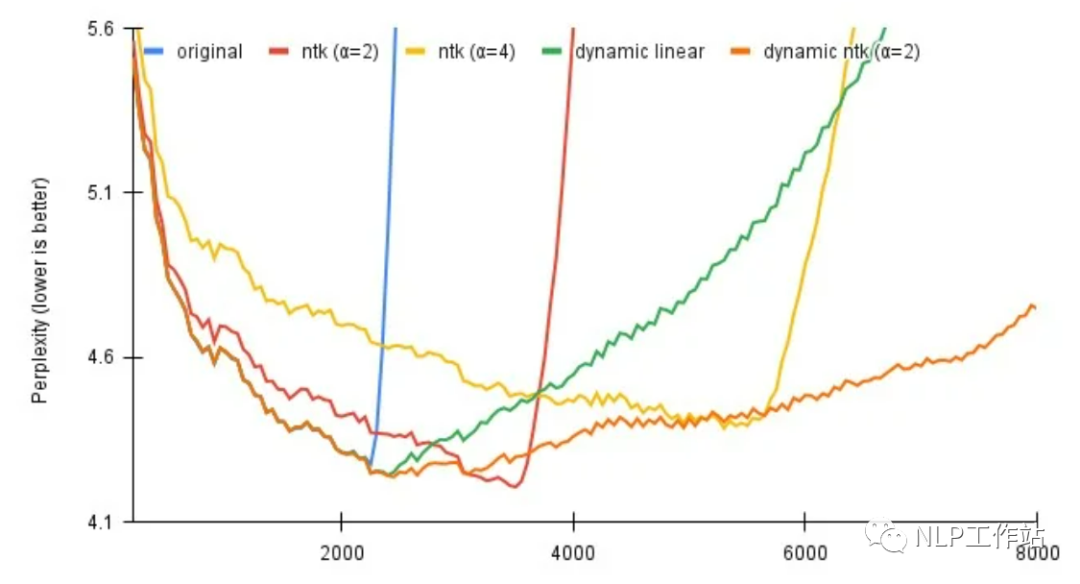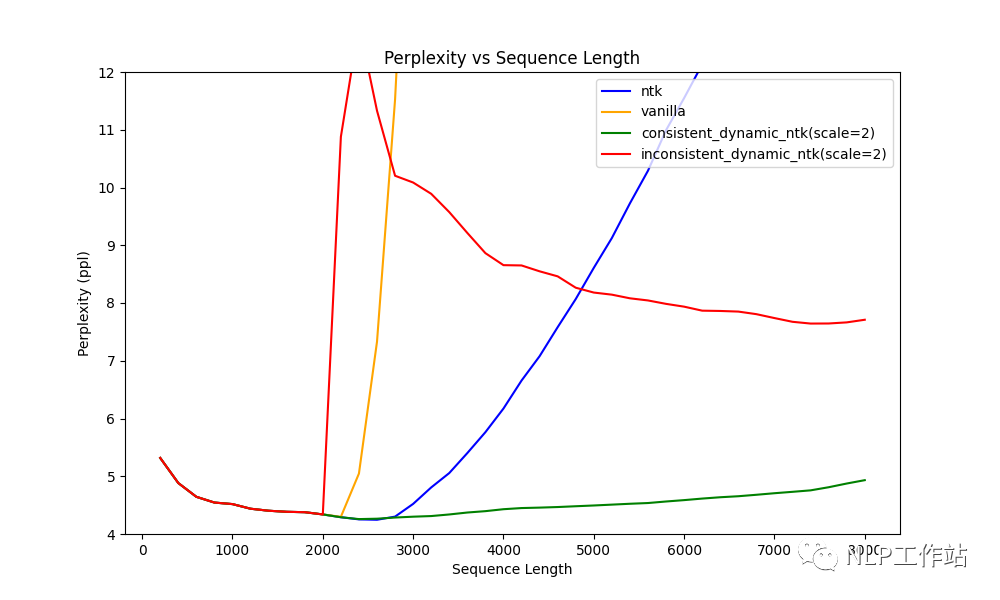

LLM的长度外推浅谈
描述
一、NBCE
NBCE:使用朴素贝叶斯扩展LLM的Context处理长度
苏神最早提出的扩展LLM的context方法,基于bayes启发得到的公式:

在问答下实测确实不错,在较长context下的阅读理解还算好用。
局限性是,无序性,即无法识别Context的输入顺序,这在续写故事等场景可能表现欠佳,做一些依赖每个context生成答案,比如提取文档摘要,效果较差。
outputs = model(input_ids=input_ids, attention_mask=attention_mask, return_dict=True, use_cache=True, past_key_values=past_key_values ) past_key_values = outputs.past_key_values # ===== 核心代码开始 ===== beta = 0.25 probas = torch.nn.functional.softmax(outputs.logits[:, -1], dim=-1) logits = probas.log() k = (probas * logits).sum(dim=-1)[1:].argmax() + 1 logits_max = logits[k] logits_uncond = logits[0] logits = (1 + beta) * logits_max - beta * logits_uncond # ===== 核心代码结束 ===== # 构建分布,采样 tau = 0.01 # tau = 1是标准的随机采样,tau->0则是贪心搜索 probas = torch.nn.functional.softmax(logits[None] / tau , dim=-1) next_tokens = torch.multinomial(probas, num_samples=1).squeeze(1)
此处代码,图片,文本均选自科学空间。
二、线性内插
llama基于rotary embedding在2048长度上预训练,该方法通过将position压缩到0~2048之间,从而达到长度外推的目的。
longchat将模型微调为上下文长度外扩为16384,压缩比为 8。例如,position_ids = 10000 的 token 变为position_ids = 10000 / 8 = 1250,相邻 token 10001 变为 10001 / 8 = 1250.125
该方法的缺陷是需要进行一定量的微调,让模型来适应这种改变。
import torch
import transformers
import transformers.models.llama.modeling_llama
from einops import rearrange
from functools import partial
class CondenseRotaryEmbedding(torch.nn.Module):
def __init__(self, dim, ratio, max_position_embeddings=2048, base=10000, device=None):
super().__init__()
inv_freq = 1.0 / (base ** (torch.arange(0, dim, 2).float().to(device) / dim))
self.register_buffer("inv_freq", inv_freq)
# Build here to make `torch.jit.trace` work.
self.ratio = ratio
max_position_embeddings *= ratio
print(f"Condensing Positional embeddings from {max_position_embeddings} to {max_position_embeddings // ratio}")
self.max_seq_len_cached = max_position_embeddings
t = torch.arange(self.max_seq_len_cached, device=self.inv_freq.device, dtype=self.inv_freq.dtype) / ratio
freqs = torch.einsum("i,j->ij", t, self.inv_freq)
# Different from paper, but it uses a different permutation in order to obtain the same calculation
emb = torch.cat((freqs, freqs), dim=-1)
dtype = torch.get_default_dtype()
self.register_buffer("cos_cached", emb.cos()[None, None, :, :].to(dtype), persistent=False)
self.register_buffer("sin_cached", emb.sin()[None, None, :, :].to(dtype), persistent=False)
def forward(self, x, seq_len=None):
# x: [bs, num_attention_heads, seq_len, head_size]
# This `if` block is unlikely to be run after we build sin/cos in `__init__`. Keep the logic here just in case.
if seq_len > self.max_seq_len_cached:
self.max_seq_len_cached = seq_len
t = torch.arange(self.max_seq_len_cached, device=x.device, dtype=self.inv_freq.dtype) / self.ratio
freqs = torch.einsum("i,j->ij", t, self.inv_freq)
# Different from paper, but it uses a different permutation in order to obtain the same calculation
emb = torch.cat((freqs, freqs), dim=-1).to(x.device)
self.register_buffer("cos_cached", emb.cos()[None, None, :, :].to(x.dtype), persistent=False)
self.register_buffer("sin_cached", emb.sin()[None, None, :, :].to(x.dtype), persistent=False)
return (
self.cos_cached[:, :, :seq_len, ...].to(dtype=x.dtype),
self.sin_cached[:, :, :seq_len, ...].to(dtype=x.dtype),
)
def replace_llama_with_condense(ratio):
transformers.models.llama.modeling_llama.LlamaRotaryEmbedding = partial(CondenseRotaryEmbedding, ratio=ratio)
三、NTK-Aware Scaled RoPE
RoPE是一种β进制编码//spaces.ac.cn/archives/9675

有意思的解释一下,RoPE 的行为就像一个时钟。12小时时钟基本上是一个维度为 3、底数为 60 的 RoPE。因此,每秒钟,分针转动 1/60 分钟,每分钟,时针转动 1/60。
现在,如果将时间减慢 4 倍,那就是二使用的线性RoPE 缩放。不幸的是,现在区分每一秒,因为现在秒针几乎每秒都不会移动。
因此,如果有人给你两个不同的时间,仅相差一秒,你将无法从远处区分它们。NTK-Aware RoPE 扩展不会减慢时间。一秒仍然是一秒,但它会使分钟减慢 1.5 倍,将小时减慢 2 倍。
这样,您可以将 90 分钟容纳在一个小时中,将 24 小时容纳在半天中。
所以现在你基本上有了一个可以测量 129.6k 秒而不是 43.2k 秒的时钟。由于在查看时间时不需要精确测量时针,因此与秒相比,更大程度地缩放小时至关重要。
不想失去秒针的精度,但可以承受分针甚至时针的精度损失。
import transformers old_init = transformers.models.llama.modeling_llama.LlamaRotaryEmbedding.__init__ def ntk_scaled_init(self, dim, max_position_embeddings=2048, base=10000, device=None): #The method is just these three lines max_position_embeddings = 16384 a = 8 #Alpha value base = base * a ** (dim / (dim-2)) #Base change formula old_init(self, dim, max_position_embeddings, base, device) transformers.models.llama.modeling_llama.LlamaRotaryEmbedding.__init__ = ntk_scaled_init
四、Dynamically Scaled RoPE

对于上面的方法二、三,都涉及到一个超参数α,用于调节缩放比例,该方法是通过序列长度动态选择正确的比例参数,效果可以看上图。
对于线性插值,前 2k 上下文的精确位置值,然后在模型逐个生成标记时重新计算每个新序列长度的位置向量。本质上,将比例设置为原始模型上下文长度/当前序列长度。
对于动态 NTK,α 的缩放设置为 (α * 当前序列长度 / 原始模型上下文长度) - (α - 1)。随着序列长度的增加动态缩放超参数。
import math
import torch
class LlamaDynamicScaledRotaryEmbedding(torch.nn.Module):
def __init__(self, dim, max_position_embeddings=2048, base=10000, ntk=False, device=None):
super().__init__()
self.ntk = ntk
self.base = base
self.dim = dim
self.max_position_embeddings = max_position_embeddings
inv_freq = 1.0 / (base ** (torch.arange(0, dim, 2).float().to(device) / dim))
self.register_buffer("inv_freq", inv_freq)
# Build here to make `torch.jit.trace` work.
self.max_seq_len_cached = max_position_embeddings
t = torch.arange(self.max_seq_len_cached, device=self.inv_freq.device, dtype=self.inv_freq.dtype)
freqs = torch.einsum("i,j->ij", t, self.inv_freq)
# Different from paper, but it uses a different permutation in order to obtain the same calculation
emb = torch.cat((freqs, freqs), dim=-1)
dtype = torch.get_default_dtype()
self.register_buffer("cos_cached", emb.cos()[None, None, :, :].to(dtype), persistent=False)
self.register_buffer("sin_cached", emb.sin()[None, None, :, :].to(dtype), persistent=False)
def forward(self, x, seq_len=None):
# x: [bs, num_attention_heads, seq_len, head_size]
# This `if` block is unlikely to be run after we build sin/cos in `__init__`. Keep the logic here just in case.
if seq_len > self.max_seq_len_cached:
self.max_seq_len_cached = seq_len
if self.ntk:
base = self.base * ((self.ntk * seq_len / self.max_position_embeddings) - (self.ntk - 1)) ** (self.dim / (self.dim-2))
inv_freq = 1.0 / (base ** (torch.arange(0, self.dim, 2).float().to(x.device) / self.dim))
self.register_buffer("inv_freq", inv_freq)
t = torch.arange(self.max_seq_len_cached, device=x.device, dtype=self.inv_freq.dtype)
if not self.ntk:
t *= self.max_position_embeddings / seq_len
freqs = torch.einsum("i,j->ij", t, self.inv_freq)
# Different from paper, but it uses a different permutation in order to obtain the same calculation
emb = torch.cat((freqs, freqs), dim=-1).to(x.device)
self.register_buffer("cos_cached", emb.cos()[None, None, :, :].to(x.dtype), persistent=False)
self.register_buffer("sin_cached", emb.sin()[None, None, :, :].to(x.dtype), persistent=False)
return (
self.cos_cached[:, :, :seq_len, ...].to(dtype=x.dtype),
self.sin_cached[:, :, :seq_len, ...].to(dtype=x.dtype),
)
五、consistent of Dynamically Scaled RoPE

方法四存在一个问题是,因为α是动态的,因为解码是有cache的,所以,在生成第100个token时,算的α和第200个token时,算的α时不一致的。
query和key的rotation base不一致,正确的应该时这样
import math
from typing import List, Optional, Tuple, Union
import torch
import torch.nn.functional as F
import torch.utils.checkpoint
from torch import nn
from transformers.models.llama.modeling_llama import repeat_kv, apply_rotary_pos_emb
from transformers.models.llama.modeling_llama import LlamaAttention
def forward(
self,
hidden_states: torch.Tensor,
attention_mask: Optional[torch.Tensor] = None,
position_ids: Optional[torch.LongTensor] = None,
past_key_value: Optional[Tuple[torch.Tensor]] = None,
output_attentions: bool = False,
use_cache: bool = False,
) -> Tuple[torch.Tensor, Optional[torch.Tensor], Optional[Tuple[torch.Tensor]]]:
bsz, q_len, _ = hidden_states.size()
if self.pretraining_tp > 1:
key_value_slicing = (self.num_key_value_heads * self.head_dim) // self.pretraining_tp
query_slices = self.q_proj.weight.split((self.num_heads * self.head_dim) // self.pretraining_tp, dim=0)
key_slices = self.k_proj.weight.split(key_value_slicing, dim=0)
value_slices = self.v_proj.weight.split(key_value_slicing, dim=0)
query_states = [F.linear(hidden_states, query_slices[i]) for i in range(self.pretraining_tp)]
query_states = torch.cat(query_states, dim=-1)
key_states = [F.linear(hidden_states, key_slices[i]) for i in range(self.pretraining_tp)]
key_states = torch.cat(key_states, dim=-1)
value_states = [F.linear(hidden_states, value_slices[i]) for i in range(self.pretraining_tp)]
value_states = torch.cat(value_states, dim=-1)
else:
query_states = self.q_proj(hidden_states)
key_states = self.k_proj(hidden_states)
value_states = self.v_proj(hidden_states)
query_states = query_states.view(bsz, q_len, self.num_heads, self.head_dim).transpose(1, 2)
key_states = key_states.view(bsz, q_len, self.num_key_value_heads, self.head_dim).transpose(1, 2)
value_states = value_states.view(bsz, q_len, self.num_key_value_heads, self.head_dim).transpose(1, 2)
kv_seq_len = key_states.shape[-2]
if past_key_value is not None:
kv_seq_len += past_key_value[0].shape[-2]
cos, sin = self.rotary_emb(value_states, seq_len=kv_seq_len)
if past_key_value is not None:
# reuse k w/o RoPE
key_states = torch.cat([past_key_value[0], key_states], dim=2)
# apply RoPE after retrieving all keys and queries
query_states, rotated_key_states = apply_rotary_pos_emb(query_states, key_states, cos, sin, position_ids)
if past_key_value is not None:
# reuse v, self_attention
value_states = torch.cat([past_key_value[1], value_states], dim=2)
past_key_value = (key_states, value_states) if use_cache else None # cache the key w/o RoPE
# repeat k/v heads if n_kv_heads < n_heads
rotated_key_states = repeat_kv(rotated_key_states, self.num_key_value_groups)
value_states = repeat_kv(value_states, self.num_key_value_groups)
attn_weights = torch.matmul(query_states, rotated_key_states.transpose(2, 3)) / math.sqrt(self.head_dim)
if attn_weights.size() != (bsz, self.num_heads, q_len, kv_seq_len):
raise ValueError(
f"Attention weights should be of size {(bsz, self.num_heads, q_len, kv_seq_len)}, but is"
f" {attn_weights.size()}"
)
if attention_mask is not None:
if attention_mask.size() != (bsz, 1, q_len, kv_seq_len):
raise ValueError(
f"Attention mask should be of size {(bsz, 1, q_len, kv_seq_len)}, but is {attention_mask.size()}"
)
attn_weights = attn_weights + attention_mask
# upcast attention to fp32
attn_weights = nn.functional.softmax(attn_weights, dim=-1, dtype=torch.float32).to(query_states.dtype)
attn_output = torch.matmul(attn_weights, value_states)
if attn_output.size() != (bsz, self.num_heads, q_len, self.head_dim):
raise ValueError(
f"`attn_output` should be of size {(bsz, self.num_heads, q_len, self.head_dim)}, but is"
f" {attn_output.size()}"
)
attn_output = attn_output.transpose(1, 2).contiguous()
attn_output = attn_output.reshape(bsz, q_len, self.hidden_size)
if self.pretraining_tp > 1:
attn_output = attn_output.split(self.hidden_size // self.pretraining_tp, dim=2)
o_proj_slices = self.o_proj.weight.split(self.hidden_size // self.pretraining_tp, dim=1)
attn_output = sum([F.linear(attn_output[i], o_proj_slices[i]) for i in range(self.pretraining_tp)])
else:
attn_output = self.o_proj(attn_output)
if not output_attentions:
attn_weights = None
return attn_output, attn_weights, past_key_value
def replace_llama_attn_with_consistent_ntk_rope():
LlamaAttention.forward = forward
审核编辑:刘清
-
什么是LLM?LLM在自然语言处理中的应用2024-11-19 4464
-
CS1-U DC/AC5-240V磁性开关长度要求2024-10-12 1048
-
LLM模型的应用领域2024-07-09 1821
-
什么是LLM?LLM的工作原理和结构2024-07-02 17784
-
hdmi线缆长度根据什么决定选择2024-06-06 5891
-
LLM推理加速新范式!推测解码(Speculative Decoding)最新综述2024-01-29 5843
-
如何利用位置编码实现长度外推?2024-01-08 912
-
使用MLC-LLM支持RWKV-5推理的过程思考2023-11-19 1696
-
对比解码在LLM上的应用2023-09-21 1132
-
中国研究人员提出StructGPT,提高LLM对结构化数据的零样本推理能力2023-05-24 3922
-
LLM性能的主要因素2023-05-22 2546
-
饿了么正式宣布收购百度外卖 后者人员架构不变以独立品牌运营2017-08-24 948
-
饿了么确认收购百度外卖!最快本周收购,百度外卖为何会变成百度的弃子?2017-08-21 990
全部0条评论

快来发表一下你的评论吧 !

